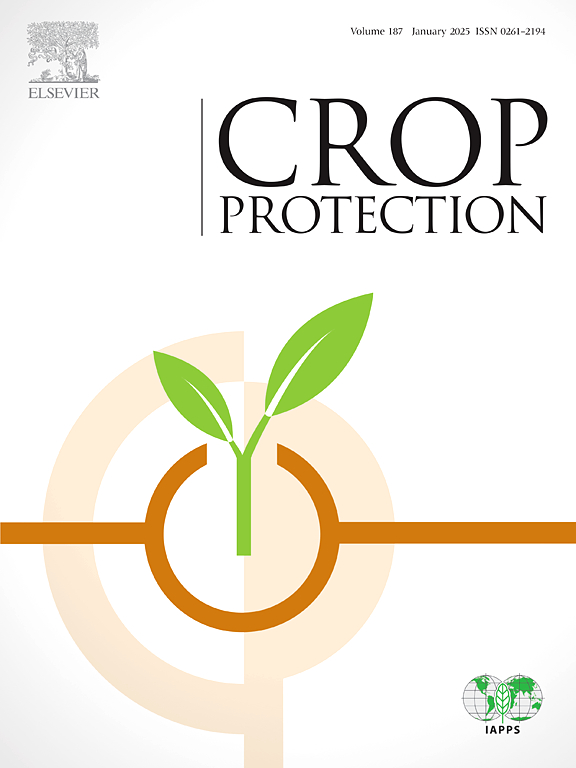挖掘亚麻籽(Linum usitatissimum L.)稳定抗性的遗传资源
IF 2.5
2区 农林科学
Q1 AGRONOMY
引用次数: 0
摘要
对印度国家基因库中的 2579 个亚麻籽品种进行了多环境筛选,以确定对亚麻籽枯萎病 Alternaria lini 具有抗性的新供体。在不同地点-年份的环境中,亚麻籽交替疫病的发病率显示出不同基因型对疾病严重程度的反应。对两地发病率的比较分析表明,雷普尔的平均叶枯病发病率(81%)高于坎普尔(43.83%),而坎普尔的平均芽枯病发病率(14.86%)高于雷普尔(4%)。多种环境下的叶枯病和芽枯病评分显示,仅有 3.41% 的受测种质(4 个抗性种质和 84 个中度抗性种质)表现出对 A. lini 感染的抗性。根据汇总的病害发生率评分,我们建立了一个由 256 个基因型组成的小型、具有代表性的 "Alternaria枯萎病抗性参考组"(RSAB),并对其抗性进行了验证。总体而言,有 1 个基因型(从 IC0591124 中选育出来的)被确定为抗性基因型,14 个基因型(从种质登录号为 IC0526066、EC0718850、IC0526032、IC0498580、IC0498580 和 IC0498580 的种质中选育出来的)被确定为抗性基因型、IC0498580, IC0499140, IC0523800, EC0718852, IC0305053, IC0597268, IC0420772, EC0041481, IC0526017, IC0498549 和 IC0597274)对所有三种 A. lini 分离物均具有中度抗性。在多达七种环境中,包括在环境控制的玻璃温室中的人工附生条件下,发现它们对所有三种 A. lini 分离物(Rpr、Knpr 和 Dli)都有中等程度的抗性。对不同质量评价标准的严格审查表明,所收集的 RSAB 有效地体现了整个收集的抗病代表性。本研究鉴定的 RSAB 种质资源和新型广谱抗病基因型为旨在开发抗枯萎病亚麻籽品种以实现可持续病害管理的育种计划提供了宝贵的启示。此外,这些遗传资源对于通过全基因组关联研究和绘制抗性连锁 QTLs 图谱来鉴定抗枯萎病基因/基因组区域至关重要。本文章由计算机程序翻译,如有差异,请以英文原文为准。
Mining genetic resources for stable resistance to Alternaria blight disease of linseed (Linum usitatissimum L.)
Multi-environment screening of 2579 linseed accessions from the National Genebank of India was undertaken to identify novel donors imparting resistance to Alternaria lini causing blight disease of linseed. Alternaria blight incidence showed a differential genotypic response in the degree of disease severity across different location-year environments. The comparative analysis of disease incidence across two locations revealed that the mean leaf blight was higher at Raipur (∼81%) compared to Kanpur (43.83%), while mean bud blight was comparatively higher (up to 14.86%) at Kanpur than Raipur (∼4%). Leaf and bud blight scores across multiple environments revealed only 3.41% of the tested germplasm (4 resistant and 84 moderately resistant accessions) showed resistance to A. lini infection. Based on pooled disease incidence scores, a small and representative ‘Reference Set for Alternaria blight resistance’ (RSAB) comprising 256 genotypes was assembled and validated for confirmation of resistance. Overall, one genotype, a selection from IC0591124 was identified as resistant and 14 genotypes (selections from germplasm accessions having National IDs – IC0526066, EC0718850, IC0526032, IC0498580, IC0499140, IC0523800, EC0718852, IC0305053, IC0597268, IC0420772, EC0041481, IC0526017, IC0498549 and IC0597274) were found moderately resistant against all the three isolates of A. lini (Rpr, Knpr and Dli) in up to seven environments including artificial epiphytotic conditions in an environment-controlled glass house. A critical examination of the different quality evaluation criteria revealed that the assembled RSAB effectively captured the representativeness of the whole collection for disease resistance. The RSAB germplasm and novel broad-range resistant genotypes identified in the present study offer valuable insights for breeding programs aiming to develop blight resistant linseed varieties for sustainable disease management. In addition, these genetic resources will be crucial in identifying genes/genomic regions underlying blight resistance through genome-wide association studies and mapping resistance-linked QTLs.
求助全文
通过发布文献求助,成功后即可免费获取论文全文。
去求助
来源期刊

Crop Protection
农林科学-农艺学
CiteScore
6.10
自引率
3.60%
发文量
200
审稿时长
29 days
期刊介绍:
The Editors of Crop Protection especially welcome papers describing an interdisciplinary approach showing how different control strategies can be integrated into practical pest management programs, covering high and low input agricultural systems worldwide. Crop Protection particularly emphasizes the practical aspects of control in the field and for protected crops, and includes work which may lead in the near future to more effective control. The journal does not duplicate the many existing excellent biological science journals, which deal mainly with the more fundamental aspects of plant pathology, applied zoology and weed science. Crop Protection covers all practical aspects of pest, disease and weed control, including the following topics:
-Abiotic damage-
Agronomic control methods-
Assessment of pest and disease damage-
Molecular methods for the detection and assessment of pests and diseases-
Biological control-
Biorational pesticides-
Control of animal pests of world crops-
Control of diseases of crop plants caused by microorganisms-
Control of weeds and integrated management-
Economic considerations-
Effects of plant growth regulators-
Environmental benefits of reduced pesticide use-
Environmental effects of pesticides-
Epidemiology of pests and diseases in relation to control-
GM Crops, and genetic engineering applications-
Importance and control of postharvest crop losses-
Integrated control-
Interrelationships and compatibility among different control strategies-
Invasive species as they relate to implications for crop protection-
Pesticide application methods-
Pest management-
Phytobiomes for pest and disease control-
Resistance management-
Sampling and monitoring schemes for diseases, nematodes, pests and weeds.
 求助内容:
求助内容: 应助结果提醒方式:
应助结果提醒方式:


